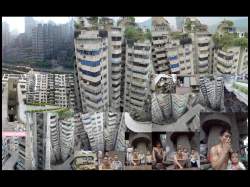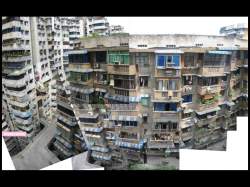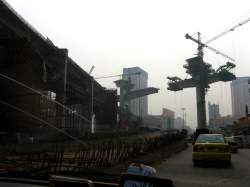Whispers of creativity
Chinese Whispers
Neville Mars and Adrian Hornsby

A Cloud of Unknowing
Chinese take-up of the creative ideal over recent years has happened at trademark super-speed. The spanking new creative economy now has appropriately flash — both in terms of look and suddenness of appearance — creative zones and districts, crammed with creative businesses offering creative goods to a creative class, all adorned with indisputably desirable “creative characteristics”. Moreover spot injections of creative industries have almost become panacean in their range of administrative uses — applicable to fields as diverse as urban regeneration, labor management, cultural identity and the perceived threat of a cultural trade deficit, education, conservation, and even environmental and ecological concerns (the latent implication being that a hipper China cannot fail to be a greener China). But the real appeal of a more creative economy lies in its twin promise to deliver on the fronts of both employment and consumption.
Rising wages in the Pearl River Delta are already threatening the region’s status as the premier cheap assembly point for labour-intensive products — a state of affairs not helped by the steady, if somewhat glacial, increase in value of the RMB. As waves of progress spread outwards across the mainland, they will carry this problem in tow. There is a growing feeling that for China as a whole to keep the supply of jobs in step with the pace of urbanization, it will need to move beyond its current factory floor status, and nurture a more services orientated and indeed creative urban dynamic. Creative jobs suggest a enhancement of the human capital involved, and hence justify the wage gains needed not only to maintain growth, but also to move toward a smoother distribution of wealth. Alongside this is the sense that greater creative production will lead to greater domestic consumption. The development of China’s internal creative industries will go hand in hand with wider spending on creative outputs, and if China can be encouraged to save a little less, so the thinking goes, pressure on the worryingly tight investment and real estate bubbles will ease. Capital will flow away from speculation and into domestic brands, and Chinese companies will increasingly be able to control not only assembly of products, but design, marketing, and even market direction. In its most grandiose formulation, more creativity equals greater national autonomy.
This somewhat theoretical enthusiasm for creativity — or at least creative industries — quickly translates into a more concrete need to produce creative environments. The crudest result is scores of creative districts which are legislated into existence, beset by development proposals, and surrounded by gawping and worried creative analysts. Can creative areas be manufactured? they ask. Isn’t there a need for a more organic aspect — a natural thronging of creative SMEs? What if the development of a new creative zone involves the displacement of people and the demolition of a culturally rich piece of the urban fabric? What is the relationship between culture and creativity? In fact, what is a creative enterprise? How should we define “creative industries”, and categorize what does and does not qualify?
This last is without question the rub. But it is also the root of “creative industries”’ success as a term. It has a curious and se-ductive intractability. China is not a simple rule of law environment, and policy makers have a distinct preference for terms which guard their meaning. The concept of creativity is, especially in a business or legal context, wonderfully definition resistant (it is ambiguous, nebulous), interpretation hardy (responds well to politically motivated applications), and semantically flexible (it can be turned on and off). This makes it ideally suited to planning, where an area of land can be given an attractive label (inferred from the premise that cultural consumption can be used as an index for urban development — hence the more creative a city, the more advanced and compelling it is) and yet real decisions about actual land use can remain essentially ad hoc and case by case.
For the same reasons the “creative district” has almost equal appeal to developers, who are able to lace a project with the significant value-add of creativity, and yet refrain from having to say quite what it is the development will be. Yet while this cloud of deferred meaning facilitates stealthy progress, it is also full of unseen hazard.
The examples of 798, Suojiacun and Gaobeidan North demonstrate how fast the policy of creative zoning and the notion of art-village-manufacture can throw up and then cut down creative urban program. In all three cases, the area’s political status — contributor to municipal creative capital — proved to be both raison d’être and cause of death. The irony of 798 is that the governmental recognition which artists fought so hard to win was, as things transpired, the very mechanism by which it was taken from their hands. In Suojiacun, a lack of clear land-use rules precipitated an almost one year wonder: the by rote invention of a international art village, followed by its 24 hour demolition by bulldozer. At Gaobeidan North the entire process was replicated on the pure paper level. Other similar occurrences lead to the cynical interpretation that while there is a policy-driven flourishing of creative communities on city-planners’ maps, the government is simultaneously targeting actual on the ground instantiations. The big lose-lose situations come when “naturally occurring” creative districts — i.e. ones which are not government planned, but are successful both commercially and creatively — are either co-opted or destroyed, and the use of the “creative” label is in fact no more than yet another more sophisticated strategy for expediting urban development.
Governmental reticence about what the creative district actually is or may be produces a risky and at times contradictory state of affairs for developers and creatives alike. But on a deeper level what it perhaps belies is a fundamental unease on the part of the CCP with what creativity in China, or what creativity with Chinese characteristics, is or may be …
Western interpretations of creativity are heavily influenced by the Romantic ideal of the creative artist — an individual who challenges society, and who through freedom of expression and the fire of his own profound and personal vision, is able to disseminate his ideas into society, and become, as Shelley would have it, its ‘unacknowledged legislator’. While arguably antiquated and essentially masculine in conception, this feeling for the lone artist undoubtedly informed the 1990s UK coining of the term “creative industries”, and has significantly shaped its meaning in the West ever since. It prizes mavericks, out-of-the-box thinking, and highly individualized responses to socio-political situations. So the problem that instantly arises when you export the term to China is that the two basic positions which it predicates are not there. Firstly, free speech — the Chinese government has an active role in content creation, not to mention content suppression. Secondly, the Chinese government does not operate robust system of intellectual property protection. The creative individual has on the one hand his mouth stopped; on the other his ideas stolen. Unsurprisingly, censorship and counterfeiting are two points which the creative-artist-fetishizing West routinely criticizes China for.
The CCP is keenly aware of these two problems, and the situation for both, in accordance with the construction of a new society, is changing. Heavy pressure from the US and the WTO has led the Chinese government to legislate more in defense of intellectual property rights (IPR), and the continuing source of complaints from Hollywood et al is less about Chinese IPR laws than their implementation. This in part is attributable to the age-old disseverment in China between central policy and local officialdom. While senior government may encourage stricter enforcement of IPR, piracy can still be welcomed at the parochial level. A classic situation is the factory producing fake brand t-shirts: the local official stands to gain from improved employment, the boost to the local economy, land deals, bribes, and even, in some cases, stake or partnership. While his operations remain under-regulated, the official is unlikely to become IPR-prudish. However as domestic enthusiasm for creative enterprise takes more solid shape, internal pressure is likely to rectify this discrepancy. Indeed in 2005 80% of IPR infringement lawsuits filed in China were between Chinese companies, indicating a growing national sense of idea-ownership.
The issue of content control is decidedly trickier, and relates to what is for the Communist Party a fraught transition. Under communism proper, creative activity was regarded as a means of propaganda production, and thus essentially a tool for population management. The newer version however suggests creative activity should be regarded as a means of converting man-hours into capital, and thus an economic driver — in truth, an industry. But unlike say steel manufacture, and just like propaganda, creative production has ideological content. So how do you treat an industry which makes money by producing ideas when idea production is supposed to be the preserve of the state? And how can you encourage free-thinking individuals when party-thinking always comes first? It’s a dilemma which strikes at the core paradox of a socialist market economy.

This governmental bind has direct impacts upon the creative sector, the most obvious example being publishing. Book production is the biggest contributor to China’s creative GDP, and yet is beset by difficulties relating to bureaucratic licensing structures and governmental restrictions upon ISBN numbers, which can be hard to obtain. The same is true of magazine ISSNs, leading to an ISSN black market, where unsuccessful or dormant magazines will illegally sell their publishing number to a new publication. The start-up may be leery of seeking a number of its own because of its charged content; equally it may be simply reluctant to enter into the form- and bribe-strewn nightmare of applying for one.
However these complications, like everything in China, need to be regarded in the context of a fast future. The more important truth about publishing is that it is itself entering a phase of radical transition, moving increasingly offpage and online. Indeed the Western ideal of the supreme creative artist is itself receding in the brighter context of web-based collaborative production, net-groups, blogs, postings, myspace, YouTube etc. People, not just a creative elite, are enormously more engaged in creative production than they were even 10 years ago, and this shift is largely due to technology. Affordable computers and digital recording equipment have given birth to a generation for whom prominent individuals will be less important than their own creative content and mass internet participation. Shelley-lovers pale and stay offline, but the kids are all clicking like crazy. It’s not just the Chinese who are shifting ideas around about what creativity means: the concept itself needs to be updated, if not fundamentally rethought.
That China will be hugely significant to the process of a global internet-driven refashioning of the creative paradigm is a datum. There were something like 137 million Chinese users when I started this article. There are many more by now. China’s online population is second only to the US, and with a far higher rate of growth (let alone growth potential), China will within the next few years become the largest nation of internet users in the world. Once there, it is likely to stay top. Already the world’s most read blog (over 100 million page views) is that of a Chinese actress-turned-director (Xu Jinglei), and, if only for sheer reason of numbers, the world’s most viewed everything (uploads, downloads, streams etc.) will soon become in some sense China-focused. It follows that the weighting of internet itself will be sliding east. With a population of 30,000 and growing too, China also boasts the world’s largest squad of internet police. The implications of these two facts for creativity are as enormous as they are unclear.
The world wide web was released in 1992, and rapidly hailed as the most unifying and democratizing development in the history of the world. As it progresses into its teenage years, it is gaining some darker qualities. The initial purity of “grassroots creativity with a global audience” has been vitiated somewhat by a number of examples of small sites which first went big, and then went corpo-rate. To name but a few, Murdoch bought myspace, Google and Yahoo did deals with repressive regimes (notably China), and as wikis-canner revealed, large corporations are manipulating the content of wikipedia to cast themselves in pinker light. Indeed it is becoming a question if the internet isn’t as ideally suited to corporate co-option as it is to bedroom stars.
A second point to note is that content-control mechanisms such as the Great Firewall of China are creating internet subsets — perhaps even internets, each with a different shade. It is striking that some of the best visited sites in the world (e.g. the BBC, wikipedia, Google) are either blocked or mediated in China. This means that one huge body of webusers doesn’t get to see what another huge body of webusers look at most. Equally China’s favorite sites are unapproachable to the vast majority of the Western online population due to a basic difficulty with Chinese characters. The implication is that the Chinese internet, with its distinctly Chinese characteristics, is actually becoming distinct.
Now when you set this essentially Chinese internet within the con-text of the first point — that of a basic internet-susceptibility to corporate co-option — and consider the relationship between the CCP and Chinese companies (which because of tight governmental control of banks and lending are all operating in the hazy world of state capitalism), both the internet, and all of its creations, start to look very different. Through laying blocks and controlling buyouts, the Chinese government is able to shape its own internet — one which is neither unified nor democratic. Content parameters and a kind of long-arm ownership of successful internet companies creates an environment of collective creativity with state guidance. The extent to which the CCP will be able to maintain its grip on both private enterprise and internet usage is open to question: international trading partners want to see freer banks, and nifty hackers are busy with mirror sites and backdoor code. But letting go entirely is certainly not a part of the party’s plan …. Creation yes, but co-option too.
It is no coincidence that what happens in China’s virtual creative space runs in parallel with what happens in China’s physical creative space. Creative potentials in either realm can be seized or snuffed out with terrifying speed. At the same time, creative activity in both is flying. Every time you look at it, conditions both are and aren’t encouraging, according to what you think creativity ought to be.
Tensions around how the imported Western concept of creative industries should take shape in China are an unavoidable contributor to the term’s highly ambiguous use. While the definition floats in limbo, spatial management (virtual and real) is contradictory, unpredictable, and in some sense, dark. But perhaps the meaning of “creative industry” is in flux equally because creativity itself is in flux. Global approaches to and uses of creative production are entering their most significant period of change — certainly since Gutenberg introduced the printing press — if not ever. What happens on the internet, more than anything else, is defined by its users. And with a vast body of users all operating in their own peculiar mediated space, China will be a major shaping force — not only on the internet — but in what being creative actually comes to mean.
06-09-2007
Follow Up Article in Urban China
The Art of Keys: Profit and Loss in the Art Village Industry
The key quality of a warehouse, from the architectural point of view, is that it is cheap to build. Form indiscriminately follows function; function rarely demands much, and the resulting warehouse will typically present rock bottom costs per square meter of built floorspace. So from the developer’s point of view, if you can throw up a few warehouses, essentially for next to nothing, then move in a bunch of artists (instead of warehouse goods), and watch to see if land values soar, you have the kind of low-investment/high-return project that is real-estate alchemy. China’s urban explosion has been fueled in no small way by speculation and, recognizing these parameters, urban development in China has found a new category of asset in the idea of a manufactured artist village. Indeed, considering the commercial potential of the creative cluster, the fact that for-profit planned creative communities are now being pursued in Beijing is perhaps less surprising than that they were for so long left to the whimsical notion of organic formation.
It is a chance felicity that artists, with mostly low rental incomes, like warehouses, which offer low construction costs. Both the light and the space to work on large pieces are favorable to the practice of art-making. In addition, there is a curious ironic urban nostalgia for ex-industrial spaces (epitomized by London’s Tate Modern, the world’s most visited art gallery, which is housed in a former power station). Happily for the developer, this sentiment seems to carry through into industrial-style spaces, even when built explicitly for conversion into artist’s studios. It is almost pedantic to worry about the ‘inauthenticity’ of the ‘created’ creative community when the creatives themselves experience remarkably few problems. However, the elusive dimension of any creative cluster development project is a staple ingredient for its potential success: how to attract the art community, or an art community, to settle there? A notable strategy for dealing with this is to bring the art community into the development process itself. The key becomes the collaboration with the prominent Chinese artist.
Leading figures of the Chinese art world are regularly involved in real-estate projects, offering consultancy, partnership, and in some cases even leading new developments. Such polyvalence often seems surprising to Westerners more used to the idea of the creative artist at odds with capitalism and the company. Yet in China the artist-realtor-entrepreneur seems more congruent with economic and social realities. Modern, urbane, affluent, internationalized, the successful artist is in fact a surprisingly suitable role model for the new China, even ranking in the top ten preferred professions selected by parents for their children in a recent survey of Chinese middle class families.
Western anxieties over the correspondence between the Chinese artist and the commercial sector no doubt derive from the Western funding environment, in which art forms are heavily institutionalized, and firmly reliant on state support. Ironically, this model of the artist as a master of funding application forms, and a bureaucratically determined mode of aesthetics, is considerably more removed from the material conditions that lead to the emergence of the figure of the artist than we find in contemporary China. Historically, artists in Europe were almost pure entrepreneurs, trusting their own skill and innovation to sell concept products to fickle and competitive markets. Without subsidy, artists have traditionally incorporated commercial activity into their operations, with creative production being carried out in tandem with business projects. Notably, one of the most successful real-estate investors in commercial property in Renaissance South London, William Shakespeare, was also a playwrite.
It would be a mistake to regard the prominence of real-estate speculation in the rise of China’s creative clusters as anything formally new. Rather, it is an expedient binding together of artists’ creative energy and self-reliance, and the financial pressures and opportunities presented by China’s booming new urban environments. What is more striking about these clusters, however, and ultimately more problematic, is how globalized they are. While the urban planning of creative districts or enclaves within the city is charmingly parochial in terms of the living communities they imagine, the trading community is unequivocally international. The last decade of super-heated sales of Chinese art, overwhelmingly to foreign dealers and collectors, has dominated China’s internal art market. The primary aim of sales to foreign buyers has informed the spatial design of creative communities, which invariably aspire to to make Western visitors feel comfortable in otherwise foreign settings, and to attract Western direct investment. In fact if the artist-developer is able to start selling his warehouses or warehouse lots to Italian galleries or shoe stores, the alchemy has manifestly worked. At the same time, this Western focus has informed creative production, bending the Chinese artworks themselves toward the tastes of prospective buyers, who in an oddly tail-eating fashion increasingly seek to buy back their own Western fantasies of Chineseness, albeit off the tip of a Chinese brush. And as foreign sales represent the ideal, their aesthetic permeates the ambitious domestic market.
Clearly, creative communities are powerfully refashioning China’s image both overseas and at home. And it should come as no surprise that they have attracted the attention of central government, who are taking serious policy measures and infrastructure development that seeks to harness creative output in order to further enhance national economic and cultural power. Simultaneously the effect of the creative community on land values draws the eyes of local officials, who have a continuous proprietorial interest in property sales and the factors influencing them, especially where foreign money is involved. The implications of this for the creative community itself – and property developers – is that as soon as an area becomes hot, it becomes potentially too hot. Political pressures brought on by the government’s twin aims of ideological control and financial reward threaten to co-opt creative spaces entirely, and in so doing potentially crush the unique entrepreneurial drive to which the art district owes it existence. Beijing’s 798 provides an early paradigm: the disused warehouses of the 1990s became the flourishing international art district of the 21st century – only land values brought in chains and hotels, and cultural values brought in scrutiny and guidance. The early figureheads of 798 have left, and the Chaoyang government now oversees site management through its business partner the Seven Stars Group. Subsequent and more explicitly planned art villages are in turn catching official interest. In the new Chinese city, it is the Chinese artist-entrepreneur who is able to unlock the innovative potential of creative clusters; ultimately though, it is the Party that turns the key.
Adrian Horsnby
Owned by neville mars / Added by neville mars / 16.3 years ago / 71710 hits / 2 hours view time
Tags
Latest Entries
Contribute
Login to post an entry to this node.









